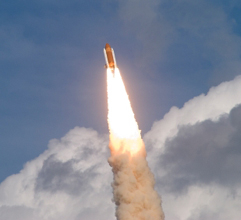Global Scans · Space · Weekly Summary

- Digital twins are a prime example of the potential of new technologies: the concept of a digital twin has existed in various forms since early space exploration, where it was referred to as a mirrored system and first used by Nasa nearly 50 years ago to rescue the Apollo 13 mission. New Statesman
- Other people working in the cannabis space are optimistic but have a healthy level of skepticism that recreational dispensaries will be able to open in early 2025. MPR News
- With many Swiss cities promoting the use of cryptocurrencies for transacting purposes, Switzerland is grabbing every opportunity to establish itself as a global leader in the cryptocurrency space. CoinTelegraph
- In 2022, China announced plans to use its Tiangong space station to test space-based solar power tech - its goal is to transmit energy to Earth in 2028. Freethink Media
- Even though individuals or civilians who wish to go into space are willing to take the risk, it becomes a concern from a health perspective. SpaceNews
- The European Space Agency and the European Commission have selected five launch companies, including four startups and Arianespace, to participate in the European Flight Ticket Initiative, a new program designed to provide flight opportunities for emerging technologies. Space Foundation
- SPRIND is part of the German Federal Government and has been set up to support innovators from Germany and neighbouring countries, creating a space where they can take risks. North West
- Crew-8 will launch a quartet of astronauts aboard the SpaceX Crew Dragon spacecraft from Pad 39 A at NASA's Kennedy Space Center in Florida, for a half-year International Space Station (ISS) rotation. Space
- Nasa and some space agencies across the globe have teams monitoring large asteroids that could be more dangerous to the planet. Yahoo News
- The Philippines' Mary Grace Gasco exploits satellite data to predict soil moisture and manage water use on farms. SEARCA
- As NASA and other space agencies send humans back to the moon and on to Mars, space weather will become a safety issue for them. Insider
- Companies like Starlink and Amazon Kuiper are expected to lead the satellite broadband marketplace with their new low-cost, flat-panel terminals. ISP Today
- Earth's orbit will be monitored by a watchful set of robotic eyes, the first commercial constellation of satellites with the ability to keep track of objects in space to avoid collisions between spacecraft. Gizmodo
- Astronauts on board the International Space Station (ISS) are about to make a new cyborg friend in the form of two short mechanical arms that will do their bidding in the cold, dark vacuum of low Earth orbit. Gizmodo
- Following Salsa's reentry, the remaining Cluster satellites will enter caretaker mode-controlled, but carrying out no new science - until they, too, reenter Earth's atmosphere in a similar fashion. phys.org
- With billions of dollars poured into space exploration each year by NASA and private companies like SpaceX, some researchers are concerned that a foodborne illness outbreak aboard the International Space Station could derail a mission. SciTechDaily
- CTP-ISW previously assessed that an Iraqi decision to expel US forces will very likely create space for ISIS to rapidly resurge in Syria within 12 to 24 months and then threaten Iraq. Critical Threats
- The space of elections during 2024 will have important consequences for the Western response to Russia's war on Ukraine. Carnegie Europe
- The first group of 9 satellites is expected to launch in April of 2027. Yahoo Finance
- Debris and unpropelled satellites naturally reenter Earth's upper atmosphere and safely disintegrate, typically in a matter of days, thereby significantly reducing the risk to other operational VLEO satellites. SpaceNews
- Private companies have been disrupting the space industry and focusing on operating in Low Earth Orbit, which is cheaper, to offer new opportunities for all manner of emerging technologies. TechRepublic
- Much of what the Pentagon is doing in space is geared toward maintaining the US military's competitive advantage against China or responding to China in cases where Chinese capabilities may threaten US assets in orbit. Ars Technica
- The European Space Agency and European Commission have selected five launch companies to participate in a new program to provide flight opportunities for new technologies, a sign of a greater role the European Union seeks to play in launch. SpaceNews
Last updated: 05 February 2024
